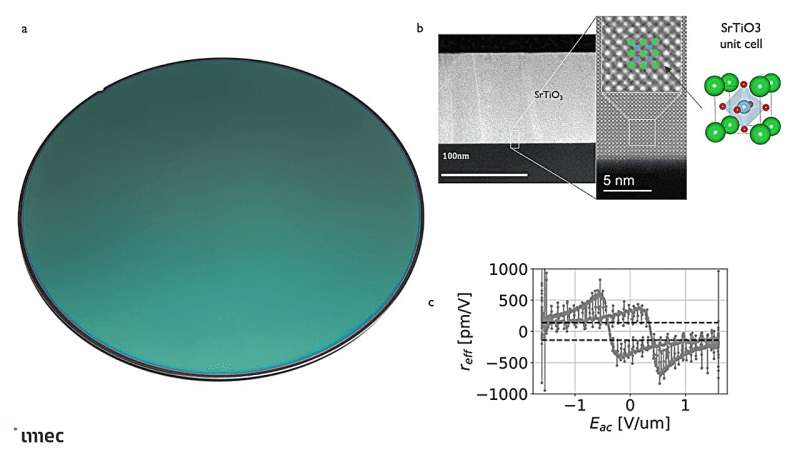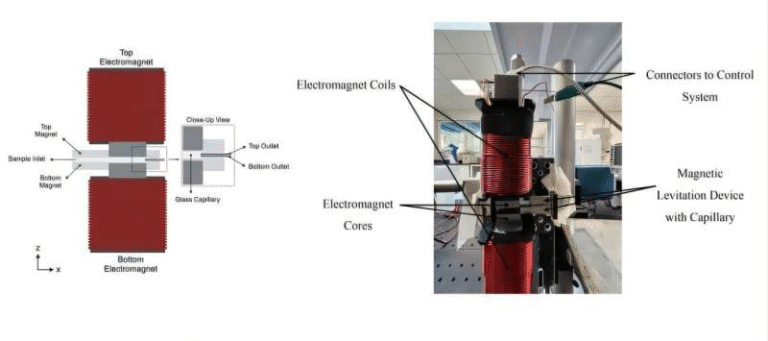Strontium Titanate Thin Film Breaks Electro-Optic Performance Record at Cryogenic Temperatures

Researchers at imec, in collaboration with KU Leuven and Ghent University, have achieved something that could reshape the landscape of quantum photonics. They engineered a thin-film strontium titanate (SrTiO₃) that not only functions at cryogenic temperatures near 4 Kelvin, but also delivers record-high electro-optic performance with low optical loss. This breakthrough, published in Science (2025), offers a new material foundation for faster, smaller, and more efficient quantum devices.
Understanding the Breakthrough
At temperatures close to absolute zero, most electro-optic materials lose their effectiveness. This is a problem for quantum computers, detectors, and photonic circuits, which operate under such extreme conditions. These systems rely on materials that can efficiently modulate light using electric fields—a property quantified by something called the Pockels coefficient.
The Pockels coefficient measures how much a material’s refractive index changes when an electric field is applied. A larger coefficient means that light can be modulated more efficiently and with lower voltage. In most materials, this value drops drastically as the temperature decreases. But in this case, imec’s engineered SrTiO₃ thin film did the opposite. At 4 K, the team measured an effective Pockels coefficient of nearly 350 pm/V, which is the highest ever recorded for any thin-film electro-optic material at this temperature.
How the Researchers Did It
The team’s approach was to take a familiar material—strontium titanate, a perovskite crystal known for being a quantum paraelectric—and re-engineer it to behave as a ferroelectric material when cooled to cryogenic levels. In its natural state, SrTiO₃ doesn’t become ferroelectric because quantum fluctuations keep the titanium atoms from settling into one orientation, preventing the material from developing the non-centrosymmetric structure required for the Pockels effect.
To overcome this, the researchers introduced strain and stoichiometric adjustments during the film growth process. This effectively broke the material’s symmetry, creating what they called a cryo-ferroelectric thin film. The change allowed SrTiO₃ to exhibit a strong Pockels effect where none existed before.
The thin film was grown using molecular beam epitaxy (MBE) on a 200 mm silicon wafer, and then transferred using wafer bonding to create a film approximately 105 nanometers thick atop a 2-micrometer SiO₂ layer. The film’s crystallinity was confirmed through transmission electron microscopy, showing clear lattice order and atomic-level alignment.
Key Results and Metrics
The results of this experiment were impressive and meticulously characterized:
- Effective Pockels coefficient: around 345 pm/V at 4 Kelvin.
- Film thickness: approximately 105 nanometers.
- Optical loss: measured in decibels per centimeter, considered low for this class of materials.
- Light confinement factor: roughly 43% in the active SrTiO₃ layer.
- Wafer size: 200 mm, confirming scalability for industrial applications.
Even at cryogenic temperatures, the SrTiO₃ film maintained its electro-optic response up to MHz frequencies, which is essential for high-speed modulation in quantum communication and computing.
Why This Matters
This development is more than just a laboratory curiosity—it represents a practical path toward cryogenic-ready electro-optic devices. Current quantum systems rely on bulky and inefficient interfaces between superconducting circuits and optical networks. A material that performs well at 4 K with both high electro-optic strength and low optical loss enables more compact and efficient quantum transducers, modulators, and interconnects.
Because the SrTiO₃ thin film is grown on silicon and compatible with standard semiconductor fabrication, it fits neatly into existing photonic chip manufacturing processes. This could drastically reduce the size and complexity of devices that bridge the gap between electronic and photonic quantum systems.
The Physics Behind It
To appreciate this innovation, it helps to understand the Pockels effect itself. When an electric field is applied to certain non-centrosymmetric materials, their refractive index changes in proportion to that field. This allows light traveling through the material to be modulated—essentially turning an electrical signal into an optical one.
In a typical quantum paraelectric material like SrTiO₃, this effect is nearly zero because the crystal structure is symmetric. However, by inducing ferroelectric polarization through careful atomic engineering, the researchers created local electric dipoles that break the symmetry, giving rise to a large and tunable electro-optic response.
The figure of merit for such materials—given by n³·r_eff, where n is refractive index and r_eff is the effective Pockels coefficient—determines how efficient the device will be. At cryogenic temperatures, this figure usually falls, but for this engineered SrTiO₃ thin film, it increased dramatically.
A Cross-Disciplinary Effort
The project was led by Christian Haffner at imec, with Ph.D. students Anja Ulrich, Kamal Brahim, and Andries Boelen playing key roles. The work required precise control over film growth, wafer bonding, and cryogenic testing. Collaborators from KU Leuven and Ghent University provided complementary expertise in materials analysis and optical characterization.
The imec team also worked in parallel with researchers at Stanford University, who reported a separate but related study. The Stanford group demonstrated that by tuning SrTiO₃’s electric-field response between 4 K and 5 K, the material can exhibit extremely strong and adjustable polarization. Together, these two studies show the versatility and untapped potential of SrTiO₃ for quantum photonics.
Broader Context in Quantum Technologies
For the quantum world, temperature is both a friend and a foe. Quantum bits, or qubits, often require near-zero-Kelvin environments to maintain coherence. But most materials that control light or electricity stop functioning efficiently at those temperatures. That’s why this achievement stands out—it closes a key temperature-compatibility gap in quantum systems engineering.
With a viable cryogenic electro-optic platform, future quantum interconnects could operate seamlessly between superconducting processors and optical networks, enabling hybrid architectures that use the best of both worlds—fast photonic communication and robust superconducting computation.
Beyond quantum technologies, these thin films could influence classical photonics as well. Compact, low-loss modulators made from SrTiO₃ could enhance telecom, data transmission, and sensing applications where low-temperature operation is needed, such as in space instruments and deep-infrared detectors.
Challenges Ahead
Despite the promising results, there’s more work to do before this material finds its way into commercial systems. The main challenges include:
- Further reducing optical losses to match state-of-the-art photonic materials.
- Integrating SrTiO₃ thin films with other on-chip quantum components.
- Ensuring uniform performance across large wafers.
- Investigating long-term stability under repeated cryogenic cycling.
Still, the results mark a decisive step forward. With such high performance achieved at 4 K, this engineered SrTiO₃ could become a cornerstone material for next-generation quantum and cryogenic photonic systems.
Looking Ahead
As the field of quantum information science continues to advance, materials that can function reliably in the coldest environments will be critical. The ability to precisely control and modulate light at 4 K paves the way for quantum links, entanglement distribution, and hybrid optical-electronic circuits.
imec’s thin-film SrTiO₃ isn’t just a record-breaker—it’s a proof of concept showing that atomic-scale engineering can unlock extraordinary functionality in materials once thought unsuitable for cryogenic operation. This is the kind of innovation that brings the dream of scalable quantum hardware one step closer to reality.
Research Reference: Engineering high Pockels coefficients in thin-film strontium titanate for cryogenic quantum electro-optic applications – Science (2025)





